Wood blewits (Clitocybe nuda, and formerly Lepista nuda) are a beautiful, delicious, edible wild mushroom every forager should know. In this post I'll tell you everything I know about hunting, identifying, and cooking them I've learned over the years.
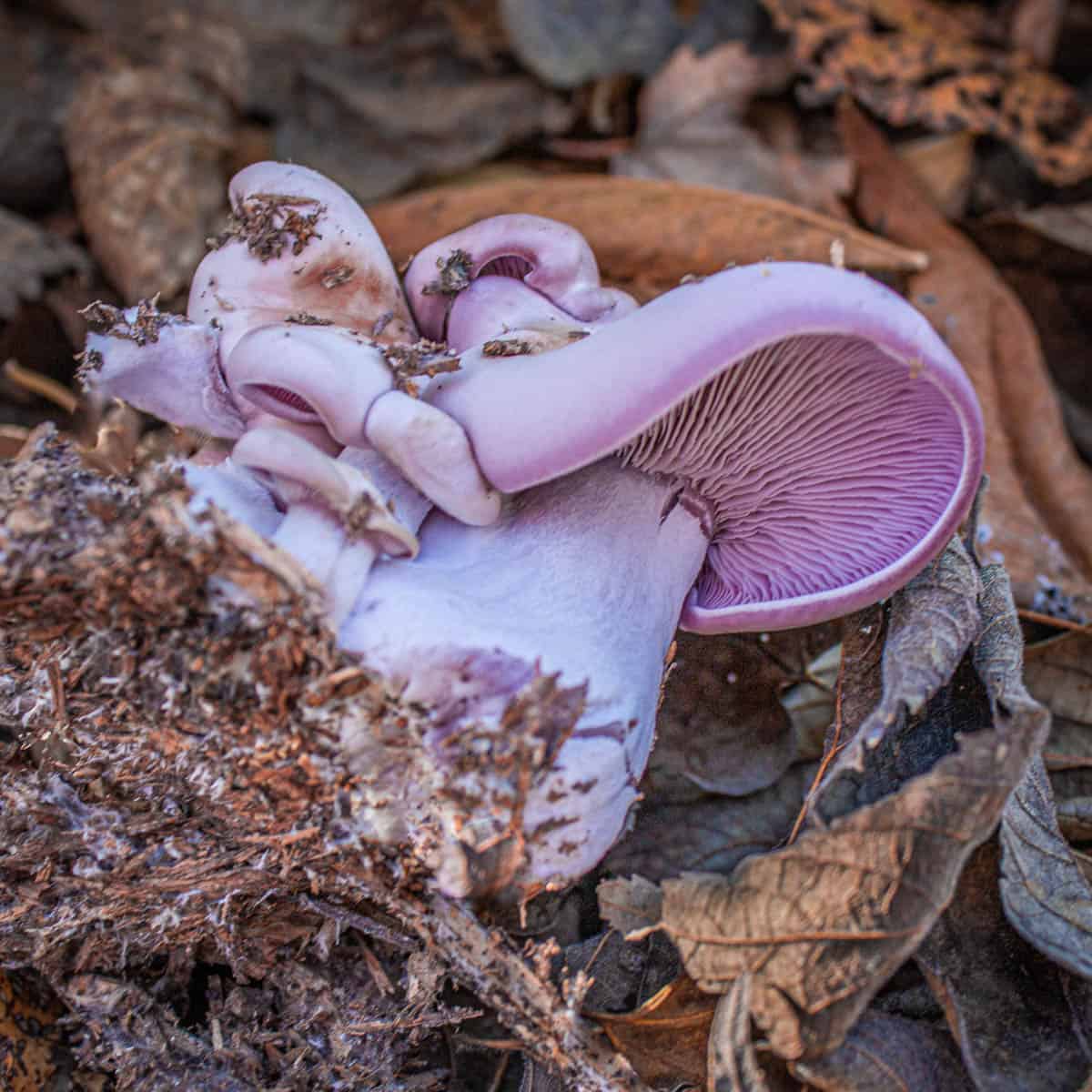
The first thing to know about these mushrooms is that they, and the information around them can be confusing. The name blewit seems to be a misinterpretation of "blue-hat" which is odd as the mushrooms are more purple than blue.
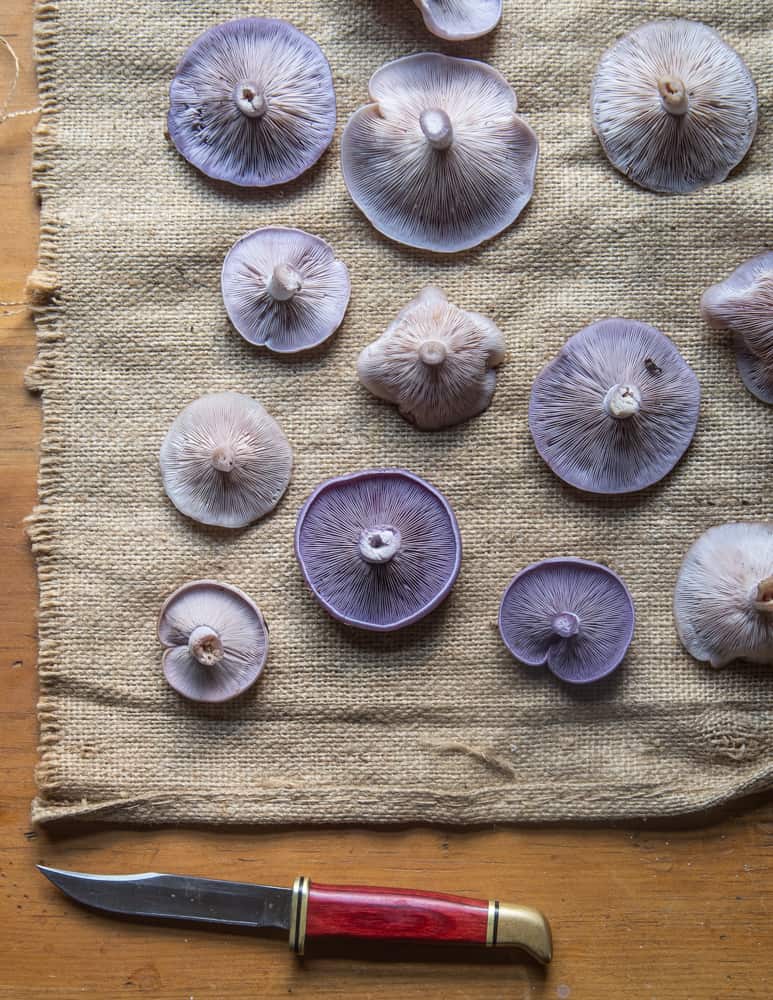
In a field guide, pictures of blewits show elegant, deep purple mushrooms, and aroma that's often compared to fruit, frozen orange juice, perfume or lilacs. Those characteristics are true sometimes, but not always. I love these mushrooms now, but identifying blewits with enough confidence to eat them took me years.
Habitat
Come October in Minnesota or when the weather gets cold I'll start to look for these. Blewits grow on debris and forest duff, so piles of leaves and pine needles are a good place to start looking. One of my best patches has mushrooms growing with pine needles.

A secret I have is that the most dependable place where I find most of my blewits growing is wood chips. During the season I've been known to drive around to every park I can find looking for landscaping and wood chip piles. More often than not where there's wood chips, there's blewits. Woods with a layer of pine needles come in a close second.
Multiple Harvests a Year
Blewit patches can fruit multiple times if they get enough rain to initiate fruiting during their season. When I lived close to a patch in the city, once I knew they'd started to show I'd check all of my patches a couple days after each rain, especially heavy downpours. David Arora writes that cut stems can regrow with the right conditions.

Identification
Looking at images of the purple mushrooms in my mind from field guides was confusing. If you take away only one thing from this article know this: blewit color is variable, and they will change color as they grow. In the book 100 Edible Mushrooms, Michael Kuo points to the color transformation is one of their distinguishing features.
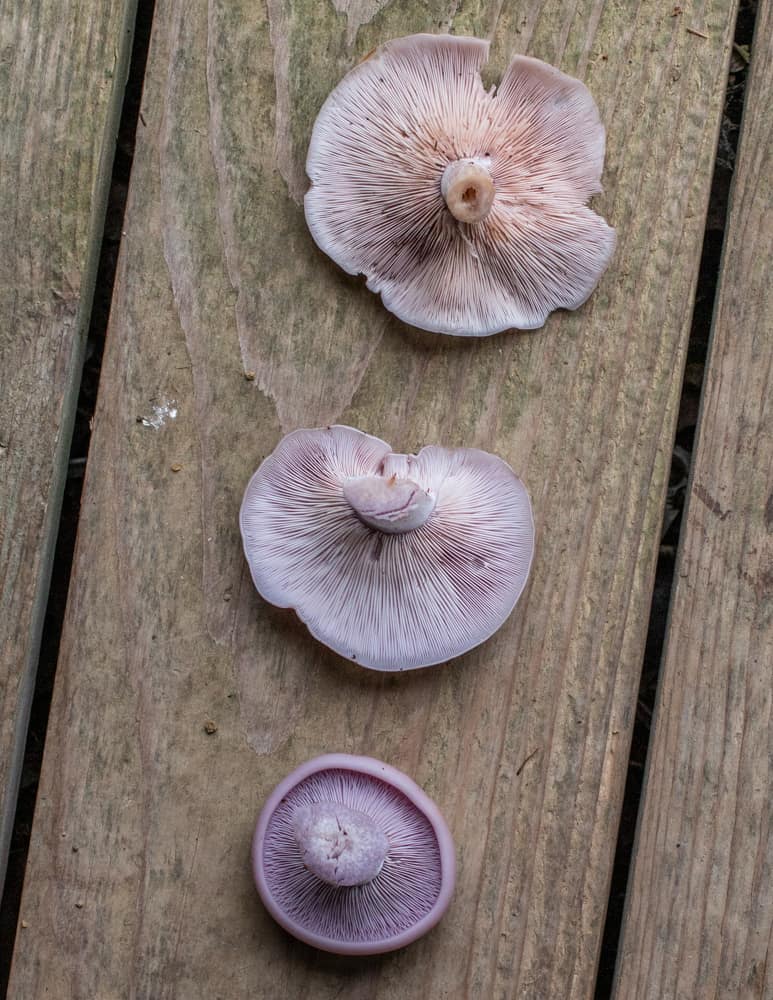
A golden chanterelle is a bright, egg-yellow during its entire growth cycle. The color of blewits varies, and depending on the age they can be lilac-colored, purple-ish, deep purple, cream-colored, or nearly brown.
Look A Likes
Once you think you're found blewits you need to know how to how to rule out imposters. Amethyst deceivers (Laccaria amethystina) can be confused with blewits, but they're edible. The big one, what you need to recognize to be safe, are dangerous Cortinarius species like purple corts (C. plumbviolaceous and others).

Some people eat violet corts, but it's best to avoid them unless you're an experience mushroom hunter. Clitocybe brunneacephala is said to look similar too, but it's edible and I've never come across it. Telling the difference between blewits and cortinarius isn't difficult once you get the hang of it. Looking for the cortina is often the easiest way to tell.
Cortinarius vs Blewits
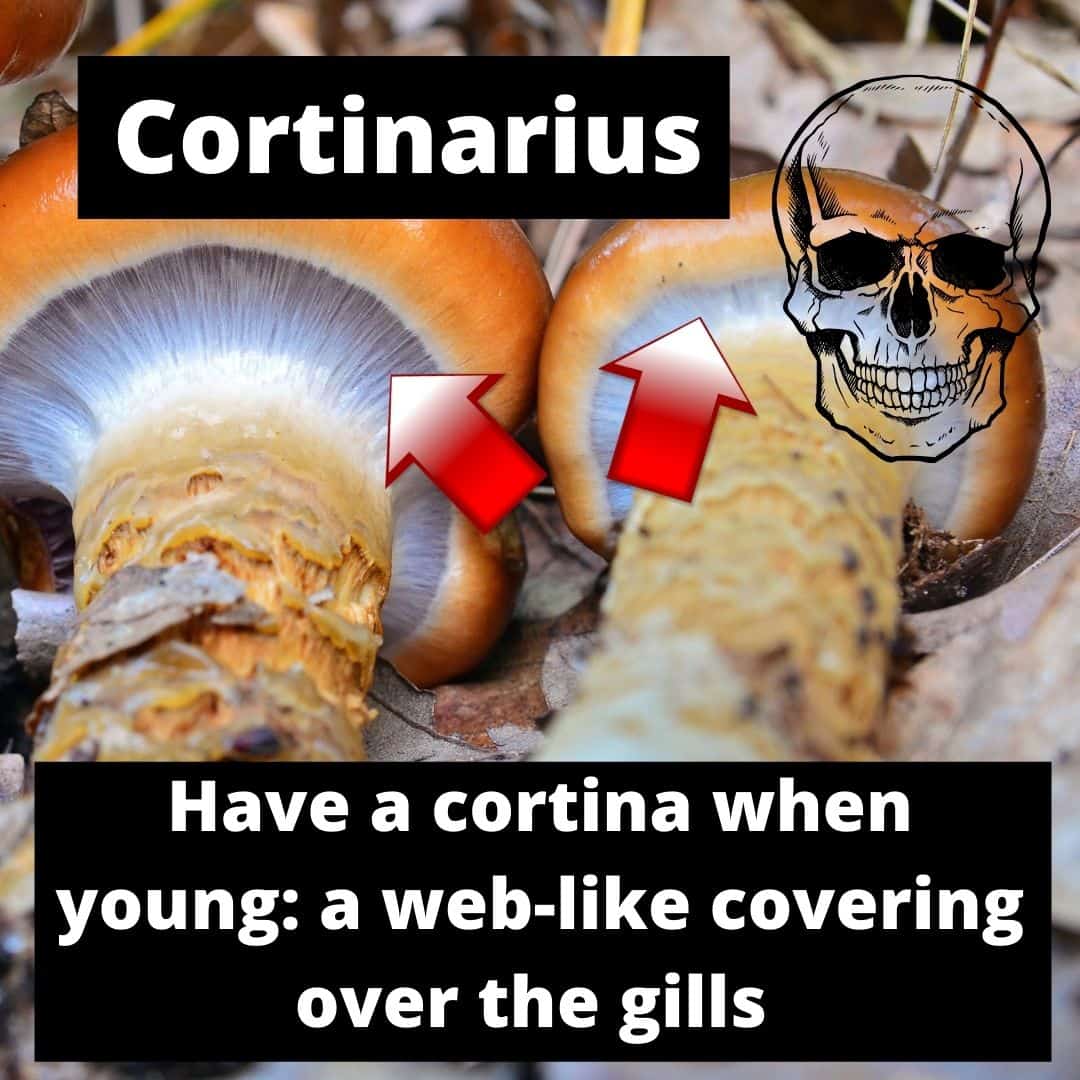
Cortinarius
- Species of cortinarius have rusty brown colored spores
- All cortinarius have a cortina: a web-like ring or veil covering over the gills when young
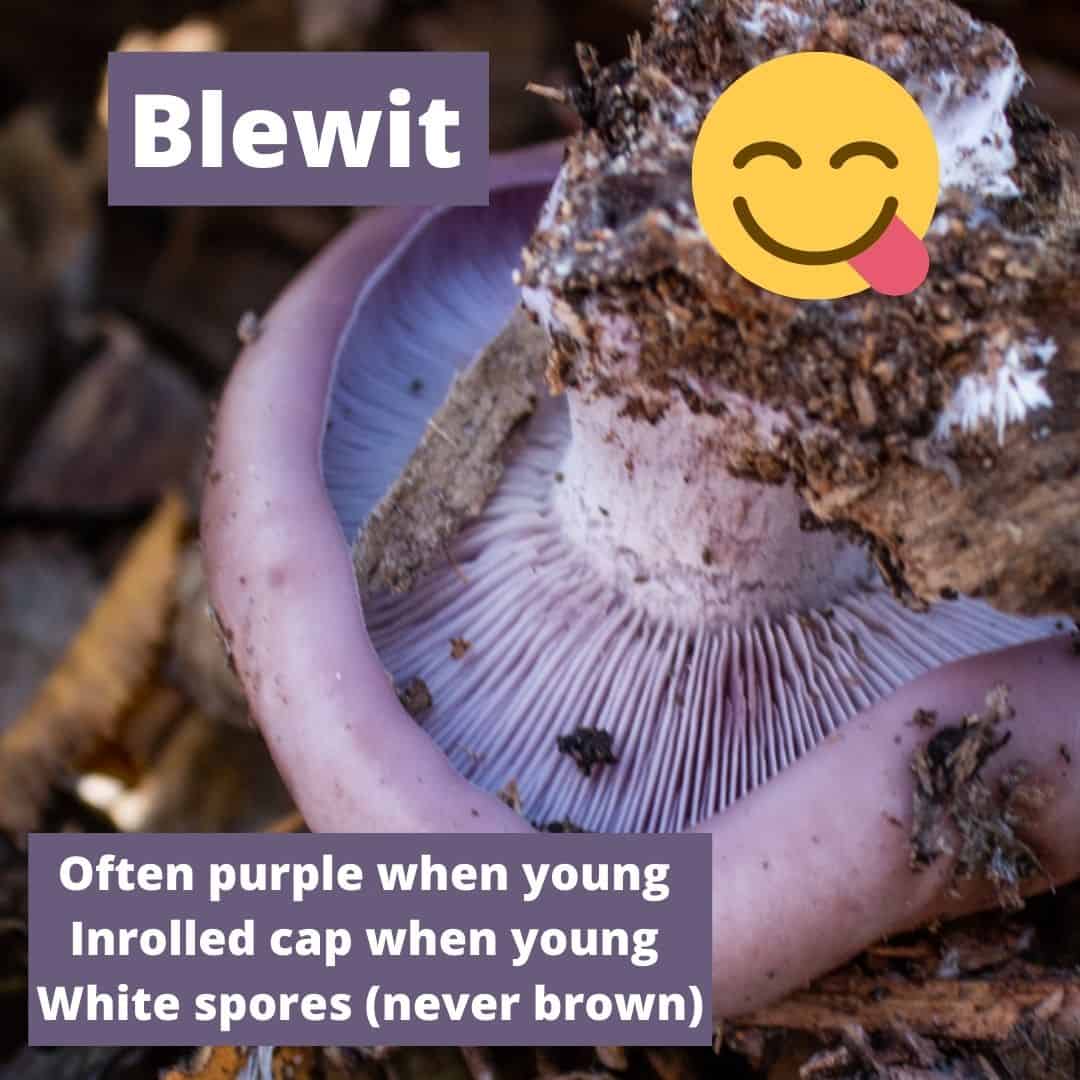
Blewits
- They have tightly spaced gills, with a notch before they touch the stem
- Seem to grow randomly in leaf litter or other organic debris
- Have a delicate fruity smell
- Often have a thick wavy edge on the cap when young
- Have a pinkish-white spore print-never brown (Cortinarius) or deep pink (Entoloma)
- Clumps of debris usually come up attached to the stems when removed from the ground
- Often have wavy cap margins, especially when young
- Lose the purple or lilac color as they age
- The cap has a subtle felt-like texture and can feel slightly tacky when wet
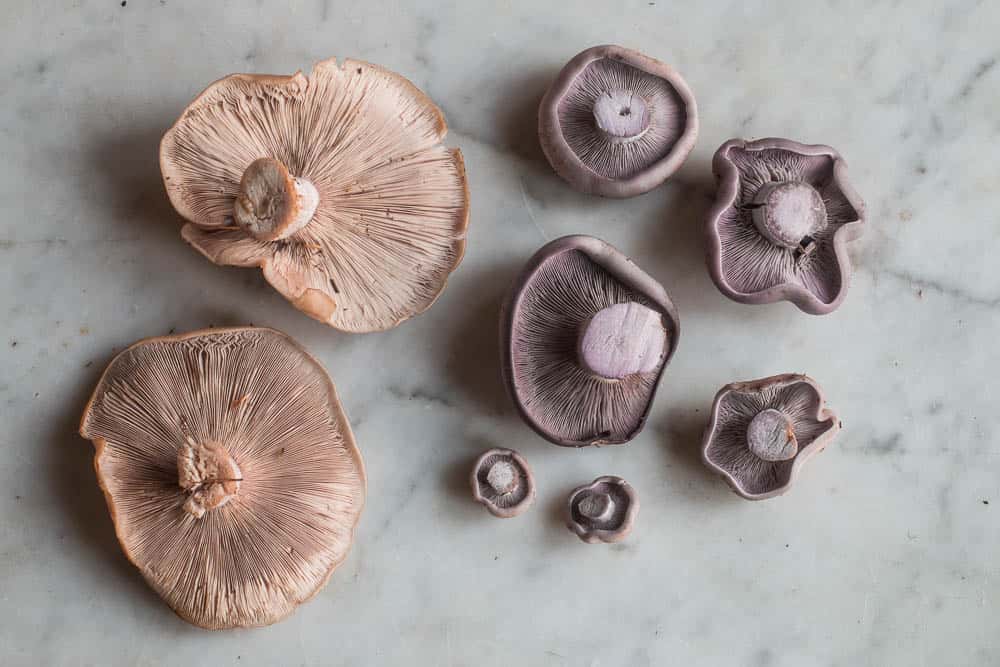
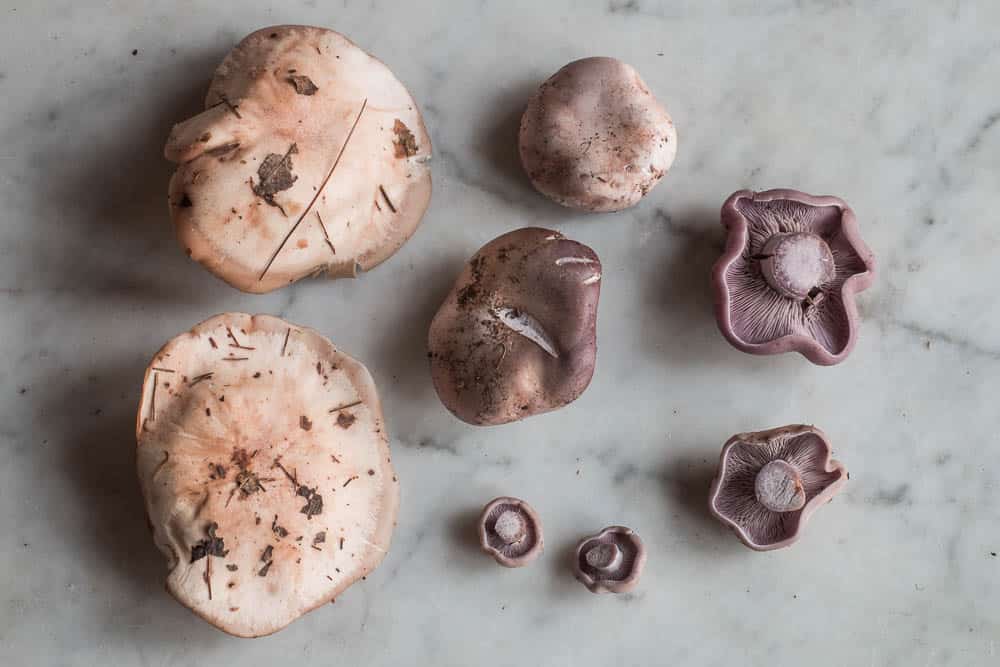
Cultivation
Bewits are sold commercially by wholesalers to chefs and restaurants. Commercial blewits are usually different from the wild ones and are often Clitocybe saeva (formerly lepista saeva) also known as the field blewit or blue leg, due to its blue stem. All cultivated blewits I've cooked have tasted watery and bland compared to wild.
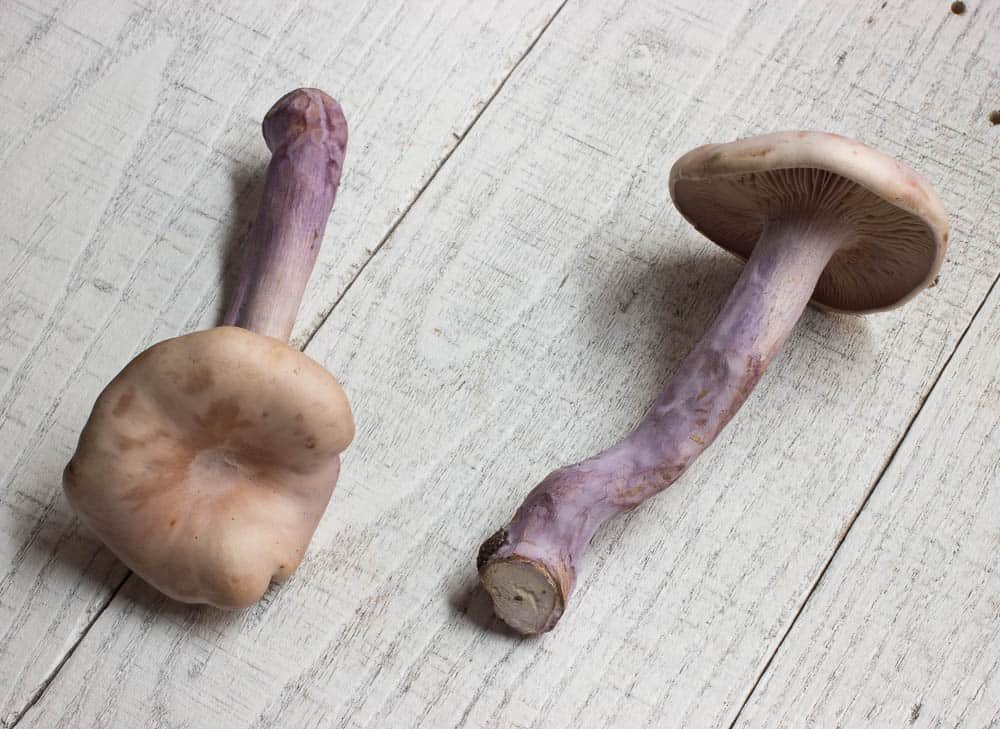
At home, you can grow blewits in your backyard on wood chips or compost piles. In his book 100 edible mushrooms Michael Kuo says blewits can even be grown on a pile of old newspapers! Stories like that have probably contributed to them being called "trash inhabitors".
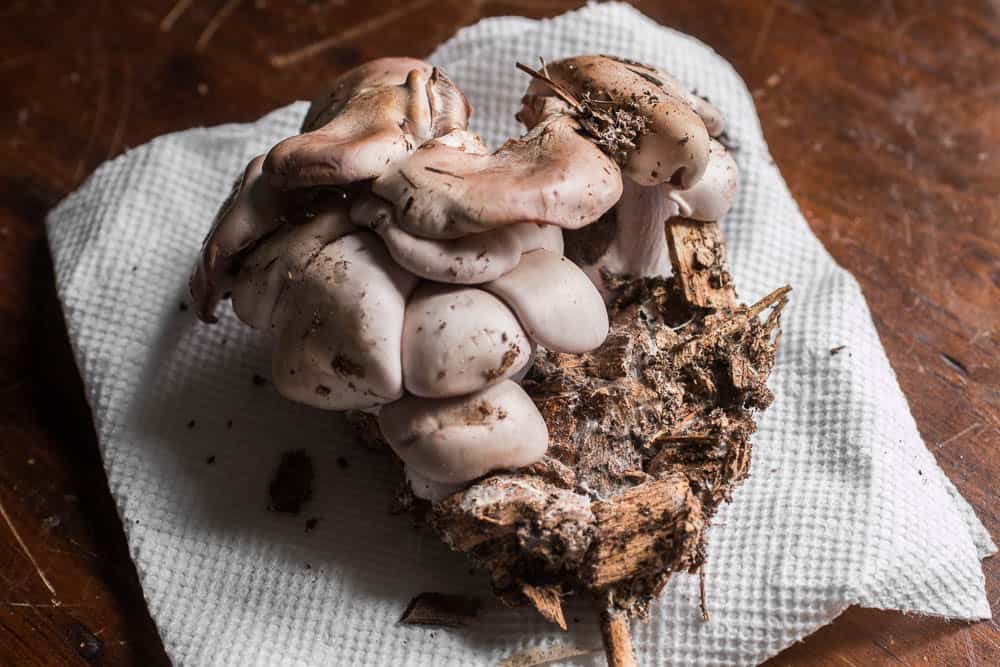
To grow blewits all you need is mushroom spawn. I buy my spawn from North Spore, and if you want to grow your own there's a link to their site at the bottom of this post, although there's more than one company that sells spawn.
Another option is to do it the old fashioned way. I know more than one person who's had grown them in their compost heap from discarded mushrooms.
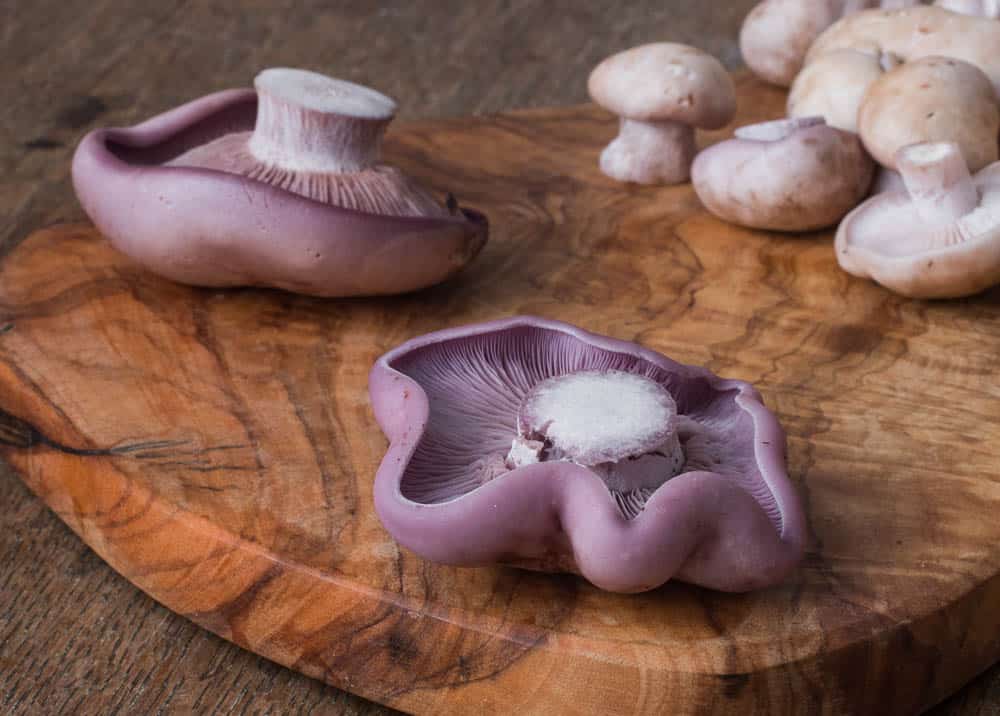
Cooking
I'd had other chefs tell me that blewits were a very strong flavored mushroom. I find them to be mild, delicate and subtle, with a great chewy texture if you leave them whole or in large pieces. Here's a few key points on cooking them I think are helpful:
- Like some other wild mushrooms, blewits must be cooked thoroughly, and never eaten raw
- If you get too creative all you'll taste is the texture of a mushroom and no flavor
- Instead of reaching for the garlic try a shallot
- While they're good cooked in a cream sauce like other mushrooms, I like them best cooked simply
- Young mushrooms and buttons are the best-cook these whole or in large pieces to preserve their texture
- Subtle flavors are the best here. Before you reach for garlic, grab a shallot
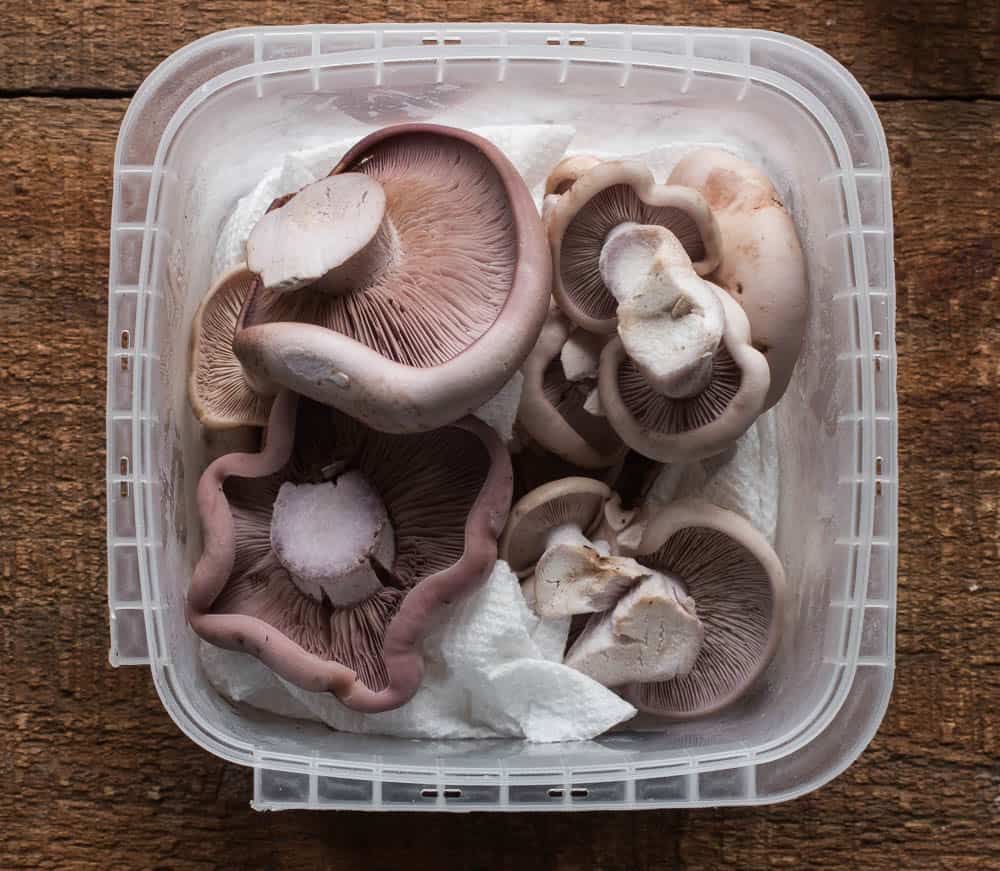
Dry Saute Technique
Most mushrooms contain a decent amount of water. Blewits contain a lot, especially after heavy rains. This makes them the poster child for the dry-saute technique, and it's a great place to start if you haven't had them before.
To make dry-sauteed blewits, put your mushrooms into a pan without oil, turn on the heat to medium-low, and cook until the mushrooms have released their water. When the pan starts to look dry, add butter or fat, salt, and other seasonings, like chopped shallots.
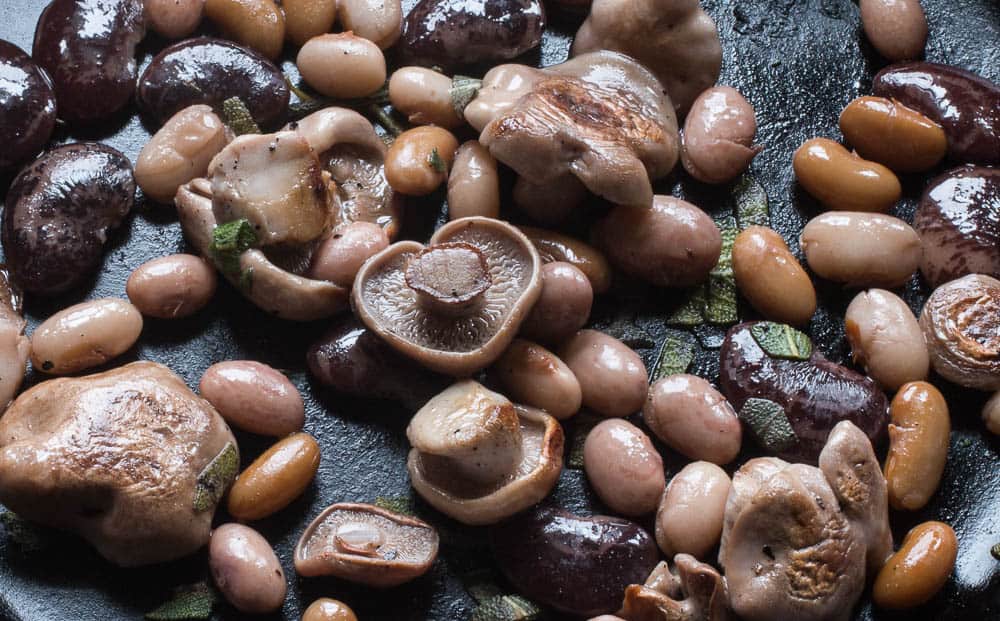
The wet saute works good with blewits too. To do that, start the pan with a splash of water and cook until the pan is nearly dry, then proceed as for the dry-saute.
Preservation
Whole or halved, young blewit buttons make great pickles. They're also good in soups or stews, and just about anywhere you'd use mushrooms.

Blewits can also be dried or dehydrated, and I often do that with older mushrooms when I have a large harvest. The dried mushrooms can be used in soups, stews and sauces.
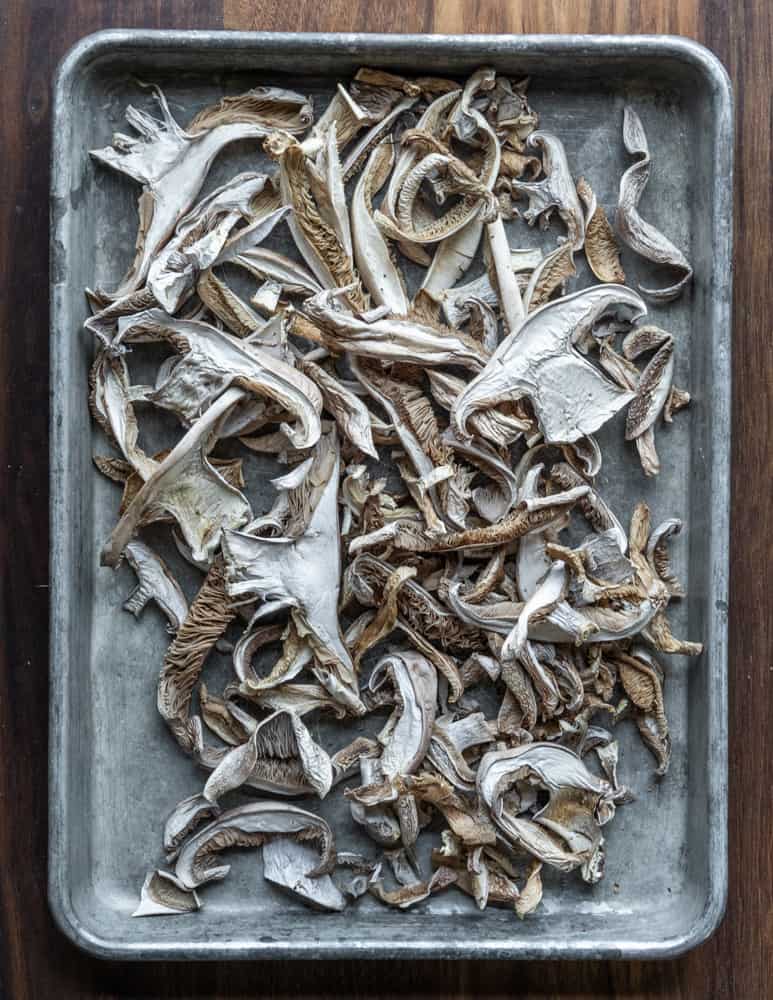
Recipes
Here's a few places I use these, as well as some of my favorite blewit recipes.
- Mushroom Conserve
- Blewit Conserve with Walnut Oil
- Pan-Roasted Blewits, Brussels, Squash and Sage
- Dry-Sauteed Blewits with Shallots and Tarragon
More
35 Essential Wild Mushrooms Every Forager Should Know

Lia Vrana
Your blog is awesome, thank for all the info!
However, I need to say that I did not like the taste of it.. I wonder whether the fact that they have absorbed a lot of water the days before foraging played a role. They were to "earthy" for me... Anyway, cheers!
Alan Bergo
Hi Lisa. Part of the fun of mushrooms is that they're all different. It's ok to not like them all.
Julie Penner
I've been finding them for about a month now. I even found two this morning after an overnight snow. How they grow from frozen ground is a mystery.
Prince Edward Island, Canada
Alan Bergo
Wow. The beauty of cold-adapted mushrooms. I’d heard of that with enoki but never blewits. Thanks for sharing.
Louise
I'm a newbie and have, to date, ID'd and eaten my first twenty species. I discovered Blewits just last week and picked about a dozen of them. Today I found what I swore was a Blewit but it didn't have a trace of lavender color left.
I could easily make out the attachment to the stipes but the stipes weren't short and stocky so I was really thrown. I posted a photo on an ID page and was given the name C. brunneocephala. Only one person responded so I'll make a spore print and hope that overnight others chime in with the same ID. I love the Blewits I found last week! Slightly sweet and silky on the tongue. But to be on the safe side I only picked the ones with obvious lavender color, or traces of it. I trusted my two guidebooks!
Maria
Just found some in our backyard growing on mulch under our cedar trees. Thank you for the cooking tips, now off to the kitchen i go to prep them :).
Alan Bergo
Have fun.
Nikki J
Found some amazing blewits near our dome space!! I made them into a mushroom soup. I am so pleased with the fact they are so cold and frost tolerant!! You really can eat wild mushrooms all year long!
-West Coast Canadian
Alan Bergo
Nikki I’m so glad you found some. We just got some rain here in MN so I’m hoping to go look for them soon. They’re a great way to end the season here.
Andy
Blewits often benefit from initially dry sauteeing with just a sprinkle of salt. They will then often release a lot of water. I sautee them until almost all the liquid is gone and then add my oil or butter. I then continue cooking them until they begin to brown and crisp on the edges. They are really good. Recently I made a very good soup by doing the initial dry sautee and cooking till about half the liquid was gone. I then blended them with sauteed carmelized onions, a little chicken bullion and some added water. They came out to a very creamy soup. Would have been even better with a little heavy cream.
Tracy D
My husband and I just foraged our first ever Wild Blewits out of the Sequoia National Forest. Thank you for these great tips. We look forward to experimenting with all these delicious looking recipes.
Alan Bergo
Hey thanks Tracy.
Charlie
I discovered blewits by uploading photos I took to inaturalist etc. and getting them identified. After many identifications I picked my first yesterday growing with its brethren under a pine or conifer (I'm not that into trees yet) and fried it in butter as a side for lunch. Vaguely slippery texture in the mouth but a fantastic taste. So proud of myself that I can find and cook wild mushrooms. Next will try honey mushrooms. Now I'm going back to the park to pick a few more blewits for today.
Alan Bergo
Enjoy your blewits!
Elizabeth
As most resources say that blewits need to be cooked, if I pickle them, should they then be edible simply by virtue of being pickled, or should you also then cook them (e.g. add the pickled mushrooms to a stew)?
Alan Bergo
IME they are edible simply by being pickled, but I typically warm pickled mushrooms up since I like them better that way. Heating them also cooks them more if you're worried about that.
Jane
Really great read!
I have been picking Lepista nuda all week. I am an intermediate forager and this article really hit home. I found my first for sure-no doubts- its purple!- mushroom today! Finally feeling comfortable enough to chow down 🙂
Alan Bergo
Great. Yes as I mention for me the key was understanding the variability of the color. Enjoy your well-earned mushrooms.
Duane Madison
Thanks Alan. I'm adding you to my favorites. The bard would say that your article and blog are a good deed in a naughty world. I just found my first blewit in a small maple grove I have for making syrup. I usually find wine caps there. The leaves are just turning and ready to fall. After doing an ambiguous and changing spore print. I finally did a google and found you. I was able to see the changes from button to flat out floppy over a 4 day period which left me wondering it it was the same mushrooms. Your article cleared that up.
I'm also located in Minnesota, I grew up on the North Shore of Lake Superior.
Alan Bergo
Thanks Duane, yes, I think my experience understanding blewits here has helped a bunch of people feel more comfortable with them. Glad to help.
Maria
Thanks for this, I picked my first lepista saeva today and although I was positive of the ID and asked some experts on a forum too I was still a little doubtful because the stem wasn't purple like the 100 + images I've seen on Google and in books. Your post is very helpful, thank you.
Sergei
Thank you for this article, Alan, that answers the question I had about these!
I have encountered these on a market this spring mixed with wild Pleurotus eryngii (apparently, they grow in similar habitats at the same time here in Kazakhstan) and was initially uneasy about them.
There aren't any notable poisonous mushrooms quite like these here and I strongly suspected that they were blewits, but since local mushroom hunting websites showed either blurry low-res pictures, competition grade photos of pretty pristine purple mushrooms, or obviously unrelated species, I hadn't been able to positively identify them.
This article confirms my suspicions, your beige colored mushrooms look exactly like what I saw.
Alan Bergo
Glad I could help. Yes, I had the same problem, most pictures are art directed and very purple, and while pretty, they don't do justice to the widely variable color blewits can take on as they age. Rarely do I see them vivid purple.
Keith
I forage for mushrooms Spring to late Fall but had never found a Blewit. But last year I found them in my backyard where we dump our Fall leaves. They were picture perfect- blue to lilac in color. I made sure to dump the leaves again in the same spot and this year I was just rewarded with another handful. Based on your advice, I will let 1-2 sporulate, and will bury in another area under the leaf litter. Foraging in the woods is great but just having to go to your backyard is even better. Thanks for the article.
Doug001
Back in England, Blewits were my first mushrooms, I found them averywhere on leaves from what is called a "sycamore" in England, (it's not the "Plane" tree of the USA i.e. Platanus, but the Norway Maple) which is considered a weed species as it is invasive and fast growing. I once found a single spore had grown on a leaf into a nickle sized perfect circle, it was the same color, and had the same smell as the blewits I had been collecting. I put it into a pile of leaves, but this shows how agressively they can grow in a single season, with this much growth in a few weeks it would compete with shaggy ink caps for fast production. I would find some of those big maple leaves before they can dry out and put them in a bag with the first blewits you find in the year, or if you don't cut them off when collecting, the bases of the stems. You should see growth the same season and if you're lucky more blewits! Another idea would be to crumble dry maple leaves and make a bed for blewits, Crumble at least 8 inches of dry maple or other "soft" leaves in an area that is shaded, wet it down and compress it, then add spores, you could do a spore print or several directly onto maple leaves, and bury them in the crumbled leaves, then bury the whole thing in a foot or so of loose leaves to protect through the winter and to further feed the mushrooms. I wish I could find them in Chicago, I wouldn't mind the maple dropping those winged seeds from a neighborhood tree landing all over my garden if I could use the leaves that come later to grow blewits. Perhaps I'll find some while working in Minneapolis this year. :o)
Alan Bergo
That's great Doug, I'm going to have to try bringing some of the leaf substrate to other places.
pete hautman
With blewit season rapidly approaching, I reread this post. Blewits are one of my favorites when they are young. I love them pickled. I have a suspicion that many of the blewit haters have been picking young Laccaria ochropurpuea (blah!) instead, as I did years ago the fist time I thought I'd found blewits.
Alan Bergo
Pete I think you're right on there with the L. ochropurpurea. They're pretty mediocre. My problem was that I had been finding blewits and bringing them home for years, but they weren't purple so I would just practice ID and chuck them in the garbage. Good luck this fall, were getting to the thick of it. A
Lauri G.
How do you pickle them, Pete?
And, I will definitely try the butternut squash, sage, and blewit recipe you've created Alan. Maybe for me, Blewits are better mixed with other vegetables.
Pete Hautman
Lauri G., I believe Alan has a good pickling recipe on this site. Not too acidic, and meant to be kept refrigerated.
Will K
I love blewits but I don’t find them that often. The first ones I found were growing in a well-composted leaf pile in my yard; I wouldn’t have seen them had I not been raking the pile up to transfer to a compost bin.
Kelly Chadwick
Fun article. I have a list of mushrooms that took me a while to get over being intimidated by their seeming ambiguity. Lyophyllum decastes, Laccaria laccata, Pluteus cervinus, and Melanoleuca are ones that come to mind. Your blog is my favorite. Keep it up.
Alan Bergo
As maddening as it can be, you know the ones that you study and study won't be forgotten. Thanks Kelly. Nice work on the Melanoleuca too, that's a trich I definitely haven't picked. I've been cautiously sampling some T. equestre for the past 2 years, wish there wasn't all the hubbub about them being potentially harmful.
Carles Isach
I ate a few Tricholoma equestre just some minutes ago, for dinner. I am the only one who eats them in the family, even if people here (Catalonia, Europe) have consumed it for centuries (not in my region).
In my country every region, even village, have it's own mushroom traditions. We don't use to pick up blewits, even if there are lots and lots of them here. We find them too strong flavoured even to mix with others. In fact, some mushroomers use to make jelly with them.
I'm struggling with some other shrooms as you did with blewits, exactly the same. But for the L. nuda I have to say that it was really easy for me. Once smelled the first one and found the aroma as descripted in guides, its impossible to confuse them.
This is the first year that I read and exchange opinions about mushrooms with Americans and Brits. Being used to Catalan, French, Italian and Spanish mushroomers and mycologist books and websites, the only big difference that I can relate is the treatement of the odour as a distinctive Id value. This is a generalisation, of course, but I think we pay here more attention to this aspect.
Just wanted to share mi thoughts and congratulate.and thank you for your web.
Alan Bergo
Thanks Carles. I know that Eastern European mushroom hunters in my area will eat T. equestre. I've eaten it a few times by myself, but have been pretty cautious about sharing since the jury seems to be out on the edibility from a safety perspective.
Laurie
Thank you for your post. I am in America but I have a friend who has friends in Catalan, so it's very interesting to me to hear about mushrooming in Catalan, as well hearing about your experience with odor, taste, and identification.
Lauri G.
I have foraged mushrooms for 6 years or so. Your deliberation about identifying Blewits according to their color draws the *perfect* picture of what it was like for me learning any new mushroom. People who know I am a mushroom hunter will ask me what is the best i.d. book, and how do you know when you have the right species, etc, etc, I think what people don't realize is that learning to identify any particular mushroom can take time and practice. Your advice "Keep going out and playing spot the blewit until you know them like an old friend" is great. I'm going to quote you if you don't mind!
I have collected, cooked and eaten Bewits several times. They taste like kittie kibble to me. I've never focused on getting buttons, though. I might have to try that. Thanks for your post!
Thomas
Hello !
Thank you for your blog, it's been a great source of inspiration to read !
I gonna try to use the best english i can to give you a little trick to help distinguish real blewits
from most of the look-alike lepista species.
If you point the cap of a blewit (lepista nuda) in direction of a light source (or the sun if you're
lucky enough) you will never see it thru. A lot of other lepista species have such a thin cap that you can
actually see the light thru it. If that can help ...
Greetings from Europe !
Alan Bergo
Thanks Thomas, sounds like a fun trick to try. Greetings from Minnesota.
David the Anal
Just an anal note: "... pouring over ..." in the prefatory paragraph s/b "... poring over ..."
Regards, and just sayin'
Alan Bergo
Heard, and thanks!
Darren
The reason they'll be named blue is because it's a very old name for them as the word purple for purple didn't exist and there was no separate word for purple it was just called blue. You see the same thing with red clover for example which is actually pink because the word pink didn't exist, the word pink for the colour comes from the name of the small carnations called pinks which are pink in colour, I'm not sure where purple came from though
Alan Bergo
That's fun. I have to assume blewit is an old synonym for blue.
isabelle Herring
I think you might benefit from some research into historical linguistics. English words have only been around for a brief time. Of course there was a word for purple Purpura, latin, has been around for a while. And you know there are 1000 hues called blue.
If you have factual/ historical evidence to support this idea of purple (violet) not having a word, please share. My studies of art history have never revealed such a thing.
Elizabeth Blair
Loved this articles, Alan. Just found my first blewits this year and in my compost pile at my cabin. Some had given me some the year before, and the cleaned blewit leftovers were tossed in the pile. This year, I found close to 100 blewits in the pile. Such a delight and used an earlier recipe posted by you on them. Delicate taste, delightful texture. Can't wait to see what my compost looks like next summer given the 100 blue blewit scraps that went into it this year!
Love your blog. Let me know when you make your next move as chef, please. Miss knowing that you're at Lucia's.
Elizabeth
Alan Bergo
Hi Elizabeth, I noticed you were picking them on the FB group 😉 As far as restaurant work, I putting together things slowly, closing Lucias was *brutal*. I'm probably going to take a consulting gig after Feb (I'll probably put a post up). Planning on taking the Spring off for sure to hunt mushies though. Best of luck getting through the winter.
Frederic Bruno
Excellent post about blewits. I am a lifelong mushroom hunter (inherited from foraging with my Italian grandparents, and I can say that I have been similarly bedeviled by the blewit color iteration issues. The cort scare was an issue at first, but easly solved by veil and spore identification. I used to also get confused by 2 very tasty look-a-likes: the purple laccaria and the winecap. It has taken me many years to feel comfortable that I really have gathered blewits.
Congrats on a great post which, for first time, has solved the blewit color conundrum. As an amateur cook, I also want to commend you on your superb and adventuresome recipes. i do, however, draw the line at Phallus Ravenelii !!
Alan Bergo
Glad I could help, thanks Frederic.